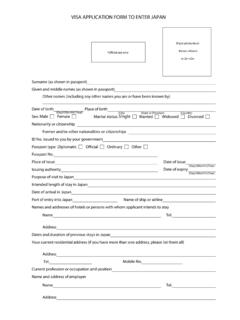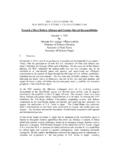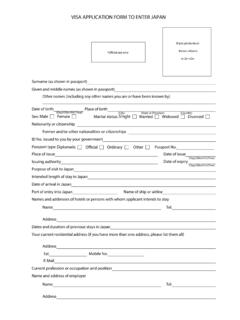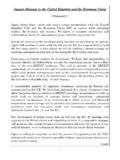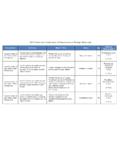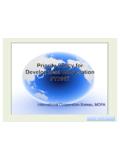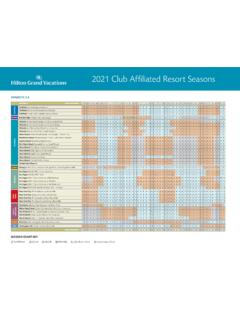Transcription of The 2030 Agenda for Sustainable Development and Japan’s ...
1 The 2030 Agenda for Sustainable Development and Japan s ImplementationMinistry of Foreign Affairs of Japan 2-2-1 Kasumigaseki, Chiyoda-ku, Tokyo 100-8919, JapanPhone: 03-3580-3311 URL: 201723 The 2030 Agenda for Sustainable DevelopmentThe 2030 Agenda for Sustainable Development (the 2030 Agenda ) is a set of international Development goals to be achieved by 2030, which was adopted at a UN summit in September 2015 as a successor to the Millennium Development Goals (MDGs) announced in international community witnessed measureable progress on the MDGs over 15 years. However, the goals on education, maternal and child health, and sanitation remained unachieved, and progress toward their achievement is lagging behind in some regions including sub-Saharan Africa. Over the same period of time, the international environment surrounding Development has significantly changed, with new challenges to combat environmental pollution and climate change, and to take countermeasures against frequent natural disasters, as well as the diversification of actors working on Development issues, such as private companies and order to address these challenges, the 2030 Agenda sets out Sustainable Development Goals (SDGs) consisting of 17 goals and 169 targets that are interrelated and closely linked to each other.
2 The key feature of the SDGs is that while the MDGs were goals for developing countries, the SDGs are universal goals applicable to all countries and include issues that developed countries must address as well, such as inequality, Sustainable consumption and production, and action to combat climate change. Furthermore, revitalizing a Global Partnership is incorporated into the Agenda so that various actors, such as governments, civil society, and the private sectors of both developed and developing countries, can work together to achieve goals and targets, using various resources, including ODA and private finance. Comparison of SDGs and MDGs MDGsMillennium Development GoalsFrom 2001 to 2015 Formulated by UN specialists initiatives8 goals and 21 targets(Simple and clear)Goals for developing countries Means of Implementation(Funding and technology)SDGsSustainable Development GoalsFrom 2016 to 203017 goals and 169 targets(Comprehensive and interrelated)Goals for all nations (Universal)Negotiated by all UN member countries Outline of Sustainable Development Goals (SDGs)Goal 17 (Partnership)Strengthen the means of implementation and revitalize the Global Partnership for Sustainable developmentGoal 1 (No Poverty)End poverty in all its forms everywhereGoal 2 (Zero Hunger)End hunger, achieve food security and improved nutrition and promote Sustainable agricultureGoal 3 (Good Health)Ensure healthy lives and promote well-being for all at all agesGoal 4 (Quality Education)
3 Ensure inclusive and equitable quality education and promote lifelong learning opportunities for allGoal 5 (Gender Equality)Achieve gender equality and empower all women and girlsGoal 6 (Water & Sanitation)Ensure availability and Sustainable management of water and sanitation for allGoal 7 (Energy)Ensure access to affordable, reliable, Sustainable and modern energy for all Goal 8 (Decent Work & Growth)Promote sustained, inclusive and Sustainable economic growth, full and productive employment and decent work for allGoal 9 (Infrastructure, Industry & Innovation)Build resilient infrastructure, promote inclusive and Sustainable industrialization and foster innovationGoal 10 (Reduce Inequality)Reduce inequality within and among countriesGoal 11 ( Sustainable Cities)Make cities and human settlements inclusive, safe, resilient and sustainableGoal 12 (Responsible Consumption & Production)Ensure Sustainable consumption and production patternsGoal 13 (Climate Action)Take urgent action to combat climate change and its impactsGoal 14 (Life below Water)Conserve and sustainably use the oceans, seas and marine resources for Sustainable developmentGoal 15 (Life on Land)Protect, restore and promote Sustainable use of terrestrial ecosystems, sustainably manage forests, combat desertification, and halt and reverse land degradation and halt biodiversity lossGoal 16 (Peace)
4 Promote peaceful and inclusive societies for Sustainable Development , provide access to justice for all and build effective, accountable and inclusive institutions at all levels45 Japan s Contribution in Africa for Achieving the SDGsJapan s initiatives for implementing the SDGsLaunch of the SDGs Promotion Headquarters and Adoption of the Implementation Guiding PrinciplesBased on a long track record of achieving Sustainable Development both at home and abroad, Japan is taking further steps, in domestic activities and international cooperation, to fully implement the 2030 Agenda , leaving no one Building the National Implementation Framework On May 20, 2016, the SDGs Promotion Headquarters was launched within the Cabinet as a new National Implementation Framework to ensure a whole-government approach. Headed by the Prime Minister and attended by all Ministers, this entity will serve as a control tower to implement, monitor and review the efforts of the Government to implement the 2030 Formulating the Implementation Guiding PrinciplesOn December 22, 2016, the Headquarters formulated the SDGs Implementation Guiding Principles as national strategy to implement the 2030 Agenda .
5 The Principles set out Japan s vision: Become a leader toward a future where economic, social and environmental improvements are attained in an integrated, Sustainable and resilient manner while leaving no one behind. The Principles also set out eight priority areas of focus by reconstructing the 17 SDGs in light of the national context, along with 140 concrete policies to implement domestically and abroad, listed with an index. 3. Taking a Multi-Stakeholder ApproachThe SDGs Promotion Headquarters emphasizes enhanced partnership with a broader set of stakeholders, and established the SDGs Promotion Roundtable Meeting where all stakeholders including local governments, NGOs/NPOs, academia, the private sector, international organizations, and various other organizations, gather and exchange implementing the SDGs based on the SDGs Implementation Guiding Principles, the Government of Japan aims to cooperate more closely with all stakeholders, utilizing the Framework, such as these SDGs Promotion Roundtable Meetings.
6 In addition, the Government of Japan is making utmost efforts to reach people nationwide through various media to raise awareness and improve understanding of the 2030 Agenda across the broader Supporting Global Implementation of the 2030 AgendaJapan is also taking proactive steps to support the global implementation of the 2030 Agenda in a wide range of areas, such as global health, disaster risk reduction, promotion of quality infrastructure investment, and women s empowerment. These steps are being taken under the Development Cooperation Charter, which has adopted the concept of human security as a guiding , Japan will support developing countries to formulate national strategies and programs and mainstream the SDGs into Security is a philosophy that aims to protect individuals and communities as well as empower them so that they can mobilize their potential to cope with a variety of threats by resolution on human ProtectionEmpowermentConflictsTerrorismL andminesSmall ArmsCurrency CrisesNatural DisastersEnvironmental DegradationInfectiousDiseasesPoverty2030 Agenda and Human Securitysecurity adopted by the UN General Assembly in 2012 calls for people-centered, comprehensive, context-specific and prevention-oriented responses.
7 This is compatible with the 2030 Agenda , based on the concepts of people-centered and leave no one behind and upholding an integration of three dimensions of Sustainable Development , environment, economy, and took the initiative to establish the Trust Fund for Human Security in 1999. This fund implements projects from the viewpoint of a Human Security Approach . By the end of 2015, 224 projects had been implemented in 88 countries and regions, and Japan had contributed a total of 410 million also supports projects with the human security approach through a variety of schemes, such as projects strengthening the Humanitarian and Development Nexus, as well as joint cross-sectoral projects undertaken by different UN organizations in Syria and August 2016, the Sixth Tokyo International Conference for African Development (TICAD VI) was held in Africa for the first time. To help implement the 2030 Agenda and other international initiatives including the G7 Ise-shima Summit in Africa, Japan committed to invest approximately 30 billion USD under public-private partnership for the future of Africa, focusing on economic diversification and industrialization, promoting resilient health systems, and promoting social TraffickingHuman Security through Inclusive Socio-Economic Development in Upper Egypt(Joint project in collaboration with five international organizations)Prime Minister Abe delivering a keynote speech at the opening session of TICAD VI(Photo: Cabinet Public Relations Office, Government of Japan The 2nd SDGs Promotion Headquarters Meeting (December 2016)(Photo: Cabinet Public Relations Office, the Government of Japan)1.)
8 Empowerment of All People2. Achievement of Good Health and LongevityPeopleProsperityPlanetPeacePart nership3. Creating Growth Markets, Revitalizing Rural Areas, and Promoting Science, Technology and Innovation4. Sustainable and Resilient Land Use, Promoting Quality Infrastructure5. Energy Conservation, Renewable Energy, Climate Change Counter- measures, and Sound Material-Cycle Society6. Conservation of Environment, including Biodiversity, Forests and the Ocean7. Achieving Peaceful, Safe and Secure Societies8. Strengthening the Means and Frameworks for the Implementation of the SDGsThese priority areas correspond with the Five Ps that are upheld in the 2030 Agenda : People, Planet, Prosperity, Peace and Partnership. Outline of the Implementation Guiding Principles[Eight Priority Areas] The SDGs Promotion HeadquartersThe SDGs Promotion Headquarters established within the Cabinet will foster close cooperation among relevant governmental agencies and lead the comprehensive and effective implementation of related measures.
9 The SDGs Promotion Headquarters Chief of Headquarters: Prime Minister Deputy chief: Chief Cabinet Secretary, Minister for Foreign Affairs Members of Headquarters: All other Ministers of StateAdministrative Meetings Chairperson: Assistant Chief Cabinet Secretary (foreign affairs) Acting Chair: Assistant Chief Cabinet Secretary (domestic affairs) Deputy Chairperson: Assistant Vice-Minister for Global Issues/ Director-General for Global Issues, Ministry of Foreign Affairs Members: Representatives of other relevant government agenciesThe SDGs Promotion Roundtable MeetingsNGOs/NPOsAcademiaPrivate SectorInternational OrganizationsVarious OrganizationsMinistry of DefenseMinistry of EnvironmentMinistry of Land, Infrastructure, Transportation and TourismMinistry of Economy, Trade and IndustryMinistry of Agriculture, Forestry and Fisheries of JapanMinistry of Health, Labor and WelfareMinistry of Education, Culture, Sports, Science and TechnologyMinistry of FinanceMinistry of Foreign AffairsMinistry of JusticeMinistry of Internal Affairs and CommunicationsReconstruction AgencyConsumer Affairs AgencyFinancial Services AgencyThe National Police AgencyCabinet OfficeCabinet Secretariat67 Japan s Efforts in Specific Areas(International Cooperation)In September 2015, the Japanese Government approved the Basic Design for Peace and Health, considering implementation of the SDGs.
10 The Basic Design aims to: 1) reinforce global health architecture that can respond to public health crises; 2) achieve Universal Health Coverage*; and, 3) make full use of Japanese human resources, expertise and technology, on health. In order to provide this support, Japan will contribute a total of about billion USD to international organizations (Global Fund, WHO, World Bank, GAVI, GHIT/UNDP). Also,in order to strengthen the response to public health crises in Africa, Japan has committed to training 20,000 specialists on infectious diseases and to increasing the number of people who have access to basic health services in Africa by as many as 2,000, efforts to achieve UHC, Japan is providing support in Kenya to strengthen management of local governments, as well as central government agencies supporting local governments, and to implement free health insurance programs and free prenatal services for families in poverty. *UHC: To ensure affordable access to basic health services for all whenever they need them through their Universal Health Coverage (UHC) (Goal 3)Kenyan healthcare finance /UHC advisors specializing loan assistance(Photo: JICA)In May 2016, Japan announced the Development Strategy for Gender Equality and Women s Empowerment, with the aim of enhancing international cooperation in this field.
